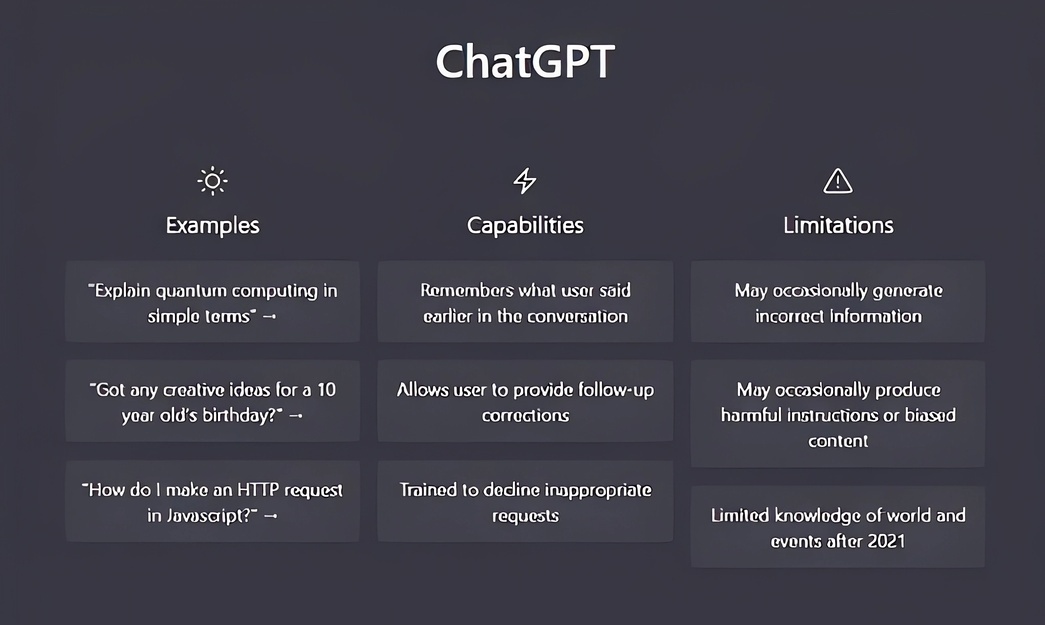
ChatGPT: The Star of AI with New Surprises
ChatGPT has become a global symbol of artificial intelligence for the general public. This conversational agent, developed by OpenAI, is not just a tool—it represents a cultural shift. Millions of people now interact daily with a machine that can generate essays, summarize texts, explain code, and even hold natural conversations. The occasional server saturation and media buzz demonstrate the extraordinary popularity of this tool. By offering free access early on, OpenAI strategically allowed people worldwide to “play” with the technology, sparking both curiosity and widespread adoption.
- Technical Operation of ChatGPT and GPT-4 -
At its heart, ChatGPT is based on the Generative Pretrained Transformer architecture, a neural network model that processes and generates human-like text. This architecture is part of the transformer family, first introduced in 2017, which has since revolutionized natural language processing (NLP). Transformers excel because they use the attention mechanism, allowing them to weigh different parts of a text sequence and capture complex dependencies between words.
GPT-4, the successor to GPT-3, contains hundreds of billions of parameters, making it one of the most powerful language models ever deployed. Parameters are essentially the “knobs” of the neural network—values learned during training that help the model associate text patterns with meaning. The larger the number of parameters, the more nuanced and context-aware the model’s responses become.
Another key innovation is Reinforcement Learning from Human Feedback (RLHF). After pretraining on massive text corpora, GPT-4 undergoes fine-tuning where human reviewers evaluate its answers, ranking them for quality and safety. This reinforcement loop improves conversational ability and reduces the likelihood of harmful or nonsensical responses. In short, RLHF gives ChatGPT its “human touch,” aligning the model’s output with socially acceptable communication patterns.
- Notable Advancements and Capabilities -
ChatGPT’s versatility is what sets it apart. Now powered by GPT-4, it is capable of performing tasks that range from academic to creative, including:
- Answering factual and conceptual questions across virtually any domain
- Summarizing complex documents or explaining scientific concepts in simple terms
- Correcting grammar and syntax in written text, helping users improve communication
- Generating code snippets in multiple programming languages
- Debugging software and suggesting algorithmic improvements
- Engaging in creative writing tasks such as poetry, storytelling, or roleplay
- Browsing the internet for up-to-date information (for users with GPT-4 browsing mode enabled)
- Integrating with over 400 plugins for specialized tasks (travel booking, financial analysis, data visualization, etc.)
This multi-functionality makes ChatGPT more than just a chatbot: it is a general-purpose assistant that augments human productivity. For students, it can clarify academic concepts. For professionals, it can draft reports, analyze datasets, or automate routine tasks. For creatives, it can generate storyboards, lyrics, or even simulate debates.
- Cultural Impact and Everyday Use -
The release of ChatGPT sparked a global conversation about AI’s role in daily life. For the first time, millions could experience an advanced language model outside research labs. This accessibility democratized AI, allowing teachers to use it in classrooms, businesses to accelerate customer support, and individuals to explore creativity. It has also fueled debates: Should students use ChatGPT to help with homework? Can journalists rely on it for drafts? Should programmers accept AI-generated code without verification?
In practice, the tool has already become a digital co-pilot for knowledge work, much like calculators are for mathematics. Its integration into Microsoft’s Copilot ecosystem (Word, Excel, PowerPoint) is a glimpse of a future where generative AI is embedded into everyday productivity tools.
- The Challenge of Bias and Safety -
Earlier conversational AIs like Microsoft Tay and Meta’s BlenderBot failed due to biased, offensive, or harmful outputs. These failures underscored how easily AI can reflect toxic content from the internet. OpenAI tackled this with RLHF and the Moderation API, which filters out unsafe content such as hate speech, misinformation, or harmful instructions.
Despite these safeguards, bias remains a challenge. Since GPT-4 learns from internet-scale data, it inevitably absorbs cultural biases, stereotypes, and errors. Mitigating these requires constant updates, better feedback loops, and transparency in how models are trained and deployed. Ethical questions remain: Should AI outputs be considered original? Who is responsible if an AI-generated suggestion causes harm?
- Economic and Educational Implications -
ChatGPT is transforming industries at an astonishing pace. In education, it can act as a personal tutor, adapting explanations to a student’s learning style. In healthcare, it assists doctors with summarizing patient records or drafting discharge notes. In business, companies use it to automate customer service, draft marketing content, and analyze data. Some predict it will add trillions of dollars in productivity to the global economy.
Yet, this disruption raises concerns about job displacement. Roles centered on repetitive tasks, like call-center work or basic content writing, may be increasingly automated. At the same time, new opportunities are emerging: prompt engineers, AI trainers, and ethicists are in growing demand. The balance between efficiency and employment is one of the central challenges of the AI era.
- What’s Next: GPT-5 and Beyond -
The future lies in even larger, more capable models. GPT-5, the anticipated successor to GPT-4, is rumored to feature more sophisticated multimodal capabilities — not just understanding and generating text, but also integrating images, video, and audio. This would allow seamless interaction across different media, bringing AI even closer to human-like understanding of the world.
Beyond scaling, research is moving toward efficiency and safety. Future models are expected to require less computing power while offering greater reliability and transparency. Policymakers, meanwhile, are working on regulatory frameworks to ensure that powerful AI systems are used responsibly, balancing innovation with safety.
One thing is clear: ChatGPT has marked the beginning of a new era in human-computer interaction. Whether as a tool, a teacher, or even a collaborator, it is redefining the boundaries of what machines can do — and what it means to be creative, productive, and informed in the digital age.